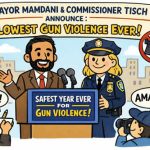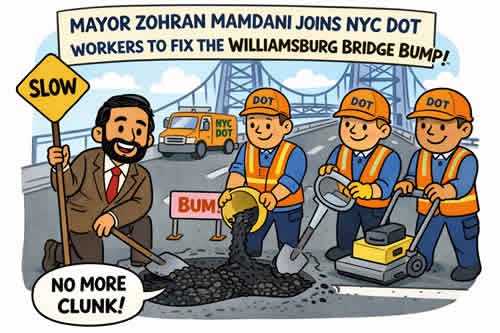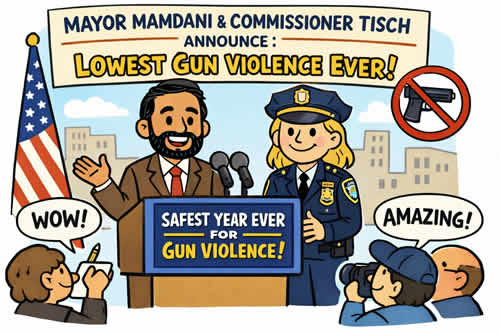Moderator: Good afternoon everyone, and thank you for joining us for today’s Public Safety Briefing led by Deputy Mayor for Public Safety, Phil Banks. Following our last speaker, we will take a few questions from the media followed by some questions that have been submitted by the public ahead of today’s briefing. I would now like to turn it over to deputy mayor, Phil Banks.
Deputy Mayor Philip Banks III, Public Safety: So good afternoon and thank you for joining. I’m joined here today by two guests, two coworkers, two colleagues, Inspector Frank DiGiacomo, who’s the commanding officer of the NYPD’s Technical Assistance Response Unit, which is referred to as TARU. And he’s going to be discussing how the NYPD, the FDNY Department of Parks and Recreation and other agencies are using technology to conduct shark surveillance near our beaches and to keep our residents safe. Unfortunately, there was an attack, a shark bite in Rockaway Beach last week. And though those attacks are statistically rare, we just wanted to keep you informed of exactly what the city is doing to minimize, to eliminate it happening again in the future. And since we don’t like to focus on statistics because they only tell a portion of exactly the element of public safety, statistically it’s rare, but if you’re the one who got bit or your family member got bit, it’s not real. We just want to make sure we put some sensitivity and we certainly wish the victim of that attack a healthy recovery. I’m also joined today by the Commissioner of the Department of Youth and Community Development, Keith Howard. Keith, how you doing?
Commissioner Keith Howard, Department of Youth and Community Development: All right, how you doing?
Deputy Mayor Banks: I’m doing well. Keith, on his leadership, his agency is going to take a larger role in public safety and he’s going to be here to tell you some of the efforts that his agencies are going to be doing. It’s a multifaceted approach. What does that mean? And we can wait till somebody shoots and arrest them. We can go take the guns off the street. But there’s also, in addition to that, and some would argue a much, much more important role to be able to find out the root causes of what’s causing that so we can now jump onto that to stop it from happening in the first place. So it’s to eliminate the violence, not to just be able to have the violence take place and to be able to capture the bad guy or the bad guys. Gun violence is not just one agency’s responsibility, it typically has fallen to police departments overall. And we just want the city to know exactly the critical role that you are playing as well. So when we do see that we are having statistically and we’re having violence going in a proper direction, New York City for this year, you and your agency deserve a large, large part of that particular credit. We just want the city to know exactly what you do.
Commissioner Howard: Absolutely, deputy mayor.
Deputy Mayor Banks: So for those of you are tuning in here for the first time, the goal of this public safety briefing is to really just to keep New Yorkers you can hear directly from the administration on what we are doing, what we’re trying to do to keep New Yorkers safe. We certainly want to hear from you. We cannot do this alone. What we’re doing good, what we’re doing bad, what we need to be improvements on, what questions that you have. And we want to be as transparent as possible. We want you to hear directly from us.
And the takeaway today is real simple, share the information. If you hear a tip, if you hear something that you think is worthwhile, share the information with your neighbor, a loved one, a parent, a child. Just grab a text, simple, “I heard this.” Text it out to someone because knowledge is power, intel is very critical.
So as I mentioned, there was a very concerning tragic incident that occurred earlier this week where women was swimming at Rockaway Beach and she wasn’t swimming far out like a deep sea fisherman. She was swimming in an area where people go to the beach and she was a victim of a shark attack. It was a very horrific attack. And we are happy that she’s recovering relatively well. And that can be a scary thing to hear. When we swim, we want to swim alone or we want to swim with other swimmers, other people. We don’t want to be swimming certainly with sharks. But even though our beaches remain safe for our families to enjoy, there was a lot of work that we put in as a city to just to be able to make sure that we’re monitoring, in fact, and to eliminate the possibility. And the mayor’s real clear about this just because we haven’t had an attack in New York City in 1953, that is not to rest on anybody’s laurels. We want to make sure that we do not suffer any attacks like that.
So you need to let us know what we’re doing and I understand that drones has been a very big part of what we’re looking to do. Since you are the expert NYPD’s expert of this, and you’ve been working with the FDNY, you’ve been working with the Parks Department, I want to turn over to you now and just let the residents of the city know exactly what you’ve been doing, and how’s it look? All right.
Inspector Frank DiGiacomo, Commanding Officer, Technical Assistance Response Unit, Police Department: First of all, I have to thank the mayor, the deputy mayor for their support with improving TARU with technology. Since the administration started, we have excelled leaps and bounds with technology. We are looking at the latest and the best technology to help keep public safety and keep the public safe. So like the deputy mayor said about the drone, so we are using drone deployment because a drone can get up there, see things, extra eyes in the sky, we can get closer to the water. So we also have our aviation unit, our harbor units, the Parks Department unit, the Fire Department, all contributing to make New Yorkers safer at the beach. So we implemented that we’re going to have drone deployments at every beach. We’re going to be at Coney Island, Rockaway Beach, Orchard Beach and Staten Island South Beach. Drone deployments will be from 09:00 to dusk. Obviously if they extend any hours or make any changes, us as a police department will go with those changes, stay as late as we need to just to make New Yorkers safe.
Like I said, we are using all resources. We’re using the Fire Department, they’re flying with us. We also have the Parks Department personnel with us assigned to the drone unit because we get a lot of questions, “Well, what happens if you see a shark?” So the first thing, if we see a shark, we notify the Parks Department. The Parks Department takes that and automatically notifies lifeguards. The lifeguards will shut down the beach immediately. Then we’ll make other notifications. We will wait and follow that shark, see where it’s going to go. And then usually if the shark goes away, it’s usually an hour after the sighting for a mile on each side of the location the shark was saw, then we will reassess and then they will open the park swimming again.
Why we’re doing this, we just want New Yorkers to know, the beach will always be open. If we see sharks and only pertains to the swimming. So if we see a shark, we’re not closing the whole beach, we’re just closing down the swimming portion of the park. Since we’ve been doing the first patrol in all the beaches, we haven’t seen any other shark sightings except for once after the victim was bit. And we assure everybody will be out there. And the drones are a vital part because they’re just given extra eyes in the sky and we also can get lower to the ground than obviously the aviation could.
Deputy Mayor Banks: So Inspector, these drones, are they tethered or untethered or a combination?
Inspector DiGiacomo: These drones are not tethered.
Deputy Mayor Banks: They’re not tethered?
Inspector DiGiacomo: Yeah, because the tethered drones are just usually drones that go straight up. We want to be over the water, so we’re using our best drones to fly over the water to zoom in with the cameras and look for anything abnormal out in the water.
Deputy Mayor Banks: So before the beach opens, before you’re allowed to go into the water, I think it’s 10 o’clock, but those hours may change. The drones are up there looking before we allow people to go into the beach to be able to see any particular site. Isn’t that correct?
Inspector DiGiacomo: Absolutely. We’re up at 09:00 with the Fire Department, with the Parks Department, we’re out there scanning the water. Also our aviation and the harbor out there too, making sure it’s safe before they open the beaches.
Deputy Mayor Banks: Right. And so what we need to get the word out to is that sometimes … We haven’t had it, so I just want to … That you have sometimes … When we either have to shut the beach or during the off hours unauthorized swimmers out there. It’s a no go. You’re not swimming out there alone. You could be swimming out there with a shark, and if the beach is unauthorized hours a lot of people are out there, you are under that attack, you’re on there by yourself. So we need you to follow those particular rules. The hours of the beach are … It’s enough time for you to go out there, enjoy yourself, but if you’re going out there doing those unauthorized hours, you put yourself at a greater risk, and you shouldn’t put undue resources on the city because we still have to go out there to help you. So please try to comply with these rules as much as possible. They shouldn’t be difficult. They’re hours. We just need to comply with them.
If you’re certainly on the beach and you see somebody in the waters during a time which they’re not supposed to be, please give 311 a call. Or if you certainly see someone who is in danger to give 911 a call as much as you possibly can.
And I just really want to reiterate the inspector, it’s like the public doesn’t want to hear a good job. They just want the services of the city. They don’t want to hear the mayor put money into this. They just want to make sure that the services are done. So I’m going to break a rule. Really, really that coordination between the NYPD, the FDNY and the Parks Department, it’s really been pleasant to see. Because for years you just did not see the coordination that was taking place between those agencies. And the mayor’s always said, it’s all taxpayer money. It’s all for the residents of the city. We all work for New York City. The package is Allstate New York City. So I’m certainly very pleased. I think he’s very happy about the coordination, how we seamlessly working together, and I just want to be able to just go on the record to be able to say thank that.
But in addition, we get a lot of compliance from the residents. People have been compliant, they’ve been asking questions, they’ve been sending in a lot of good suggestions, we have been speaking to and identifying like shark experts throughout the city. And certainly we are going to be looking to take some trips to be able to determine, since this is a rare situation for New York City, we want to make sure that we’re not behind the eight ball on this, that we are getting ahead of that. And as far as the drone technology, we could put a lot of resources into drone, but the commitment that you do have and your members have, and you’ve given me multiple, multiple presentations, I see you have some of the members of your team here. The city’s a lot safer from the efforts that are taking place. I just want to say thank you for that.
Inspector DiGiacomo: Thank you boss. Appreciate it.
Deputy Mayor Banks: So everybody knows that one of the administration’s top priorities is to end gun violence. The mayor, he ran on it. He stated it all throughout his campaign, and it is we have to be safe. We have to be safe, we have to be safe. And one of the staplers of being safe is gun violence. Bullets go off. This is not like a radar. They don’t necessarily go for the intended target. And even if they were, that still would be not good. But they fly and everybody’s at risk. So we have our good commissioner here, and he has done a lot of work on the back end to stem the violence. How do we keep the guns out of the people who would be firing them? How do we change the mindsets of people to realize that that is not the answer to any problem that you’re looking to solve?
And though we statistically are doing a great job with gun violence, 274 fewer people have been shot this year as compared to last year. 275 people. How many people are alive because of what we’re doing? And that’s fine. It doesn’t help if you’re the victim of a gun violence, and that’s why I never like to overly go with statistics. But the mayor always says about an upstream way. There’s always an upstream way to do it. Last week, the mayor released his blueprint for community safety, which includes almost $500 million in investments to create safer communities, and he dumped a lot of that on your lap, big guy. So can you let us know what you’re working on, your administration is working on?
Commissioner Howard: Absolutely, deputy mayor. So I just want to first start off by just basically saying I’m proud that DYCD serves everyone from kindergarten to older New Yorkers. We like to say that we are a small agency with a large footprint. DYCD is integrating violence intervention programming into our portfolio. This means more coordinated services for New Yorkers at risk of gun violence.
Deputy Mayor Banks: Why DYCD?
Commissioner Howard: Our agency has a proven track record of community programming and connecting participants to services throughout the city. We also have a longstanding relationship with NYPD, as you know. Our Saturday Night Lights programs, our summer youth employment program, which NYPD in an amazing way stepped up this year and had 1000 young people in summer youth employment programs, participants this year. Last year it was 813. They’ve increased dramatically. Record number.
We have a robust agency data collection and a demonstrated capacity to pay out contracts expeditiously to our community-based partners. I want to thank Mayor Adams for entrusting DYCD in taking on these vital responsibility. As you heard the deputy mayor say, and you also heard the mayor say, intervention and prevention are key to public safety. DYCD helps address crime and violence by integrating upstream solutions into our programs, including our beacon programs that are running our schools, our Cornerstone programs which are community centers that we partner with NYCHA, our Compass and Sonic afterschool programs. The Summer Youth Employment Program. I just spoke about that. Our Work Loan and Grow program, which deals with paid internship year round for in-school youth. Our Fatherhood Initiative, we also contract and have amazing community-based organizations run our food pantry programs and our runaway and homeless youth program.
We also are zeroing in, Deputy Mayor, on the top six precincts that represents 27% percent of all of the shooting incidents citywide. This includes the 40, 42, 44, 47 Precinct in the Bronx and the 73 and 75 Precinct in Brooklyn. As an agency, we are prioritizing these communities throughout our programs.
In addition, as I mentioned before, our Work Loan and Grow program based upon the mayor’s funding, has been extended to provide 7,000 high need students with meaningful paid work and career exploration opportunities year round. We’ve also expanded our workforce programs to serve even more out of school.
Programs to serve even more out of school, out of work young people. Now, new to DYCD this year is the Office of Neighborhood Safety and the Precision Employment Initiative. This includes ATLAS and evidence-based violence prevention model to serve people at high risk for rearrest. The mayor’s action plan for neighborhood safety, which we call MAP, which targets public housing development that face the highest rate of violent crime, the Precision Employment Initiative, which offers paid training, career readiness and job opportunities for at-risk New Yorkers and the crisis management system, a network of programs and partners that promote peace, community and healing, and neighborhoods most impacted by gun violence. The crisis management system includes the Cure Violence groups, a public health model, which interrupts the spread of violence by engaging the highest risk individual and changing social norms. These efforts are located in specific areas determined by NYPD data.
Want to give Chief Lipetri a nice shout-out for being so responsive to us. And of course it also helps with the community providing input. DYCD is laser focused on public safety and ensuring that everyone, especially our youth, has an opportunity to thrive. We look forward to making every neighborhood safer for all New Yorkers. So an upstream prevention approach, that’s what the mayor wanted and that’s what the funding actually provided, the additional funding that you mentioned and also what the Gun Violence Task Force has laid out for DYCD.
Deputy Mayor Banks: So you get somebody and he’s involved or she’s involved in a shooting and I’ll pick 17 years of age. And you ask yourself, I mean, we could say, “How’d the person get the gun and who gave him the gun? And what was the dispute about?” But it is just like the mindset. Why did this particular individual feel as though that this is something that was going to solve whatever issue that they had? And that’s the stuff that we have to really be able to as a city, continue to invest in. Right? Because if you change the mindset and change the opportunities, then people don’t look for that venue to solve any issues that they have. But a couple of things you said, I want to go back on, just go into detail. What is the Work, Learn & Grow program? What exactly is that program? How does it operate?
Commissioner Howard: So the Work, Learn & Grow program, we provide slots through our network of providers. And these young kids actually work at business and corporate and sometimes in nonprofit organizations. And it’s like a co-op program. One week they go to school, one week they work and it targets juniors and seniors.
Deputy Mayor Banks: In high school?
Commissioner Howard: Yep. Mm-hmm.
Deputy Mayor Banks: Now, because we’re going to start to have in future weeks members of the Cure Violence Network on to explain, can you give just a real quick briefing to our viewers on the Cure Violence Program, the concept behind it, and how do you feel it’s going?
Commissioner Howard: So the Cure Violence through the crisis management system is 40+ organizations where they have real credible messengers that are out there on the streets talking with community, talking with young people, where the goal is to try to interrupt any type of retaliation that’s going on that may happen in our communities. They already have relationships in those communities and they’re able to talk to the young people to perhaps get them to not pick up a gun because as the mayor often said, “By the time that young person picks up a gun, we’ve already lost them.” So it’s the relationship in the community, it’s the relationship building that is key to the global peace model, a model that originated out of Chicago that came into New York City in the past 10 years, and now the mayor is looking how we can build it out, provide more resources to the Cure Violence groups, to be able to do more in those communities and fund them so that they can do more.
Deputy Mayor Banks: And we are going to learn more as a city about what Cure Violence does. Many people refer to them as one of the unsung heroes of New York City. And certainly when I speak about 274 fewer people being shot, they certainly played a factor into that particular reduction. Solving these problems in public safety is not, will not, and won’t ever solely or should not be the responsibility of just people who just wear a uniform. Vital and critical is important, but it’s also important for those residents who live in those particular neighborhoods for us to arm them with information, for us to treat them, we care for them and give them a pathway to be able to contribute to public safety as well. And I would argue that all of the success that I’ve seen in my time working for the city becomes a public violence, that the residents of New York City has been the unsung hero.
And I just want to say thank you to out there, but we need to continue because this is a fight that just never ends. We just have to continue to get better and better and better and better at it as we develop into really having a city of safety. So like never ending, we’re going to continue to do it and we’re going to get some successes. We’re going to get some blips down the road, but overall, if we realize is that we have the same goal and work together, we could do quite well in that particular area there as well. So with that, I’m going to kick it to you, Derek.
Moderator: Thank you Deputy Mayor. We have one question. Chris Sommerfeldt from The Daily News has his hand raised. Chris, you can now unmute your line. Just a reminder, we’re only taking on topic questions at this time.
Question: Hello? Can you hear me?
Moderator: We can.
Question: Okay, perfect. Thanks for doing this. Just had some specific questions about the drones that are going to be deployed for shark monitoring. Did I understand it correctly that these drones will be flying seven days a week between 9:00 AM and dusk? And if so, how many drones are we actually talking about that will be out there between those hours? And lastly, what type of cost will come with that type of monitoring?
Inspector DiGiacomo: So we will be flying seven days a week. We will be using our drone technology to fly. The cost is that I’m using TARU personnel to do it. The goal eventually is so we are partnering up with the fire department and us and the parks department is our notification means when we’re doing it. Eventually the Parks Department will learn to fly their own drones, but that’s going to take a little time because the fly drone, obviously you have to have certain qualifications and you have to go through some training. So hopefully by next summer, the parks department will have their own drones out there. But until that happens, we will be flying the rest of the summer seven days a week from 9:00 AM till dusk.
Moderator: Thank you. Earlier this week, the administration reached out to New Yorkers asking them to submit questions for the officials that have joined us here today. We will now get to as many of those as we can with the amount of time that we have left. Our first question comes from Stu in Brooklyn about shark surveillance, who asks, “How does drone shark monitoring work? Does someone have to be watching a live feed constantly?”
Inspector DiGiacomo: So yes, we are doing the drone detection. We have our pilots doing a live feed, and they actually can make the determination live on the spot. And like I said, the notification is the most important thing. So having a Parks Department person with communication with the lifeguard is the most vital thing. So having a live pilot, watching a monitor, seeing what’s out there, that’s our goal, to have instant response and keep the public safe.
Moderator: Next question comes from David in the Bronx for Commissioner Howard who asks, “Can you speak more about ways our young people can connect with the CMS programs and deepen relationships to keep guns out of our schools and off of our streets?”
Commissioner Howard: Thank you for the question. The community, the Cure Violence groups that are out there doing the incredible work in our communities, they have, and part of their base motto, is to do community convenings. You’ll see some of the groups out doing barbecuing, and some of the groups will actually be out having sporting events. Some groups will do community concerts. So there’s a variety of different ways to connect with those groups in those communities in those districts. Anyone who has a question on where is the nearest Cure Violence groups in their particular neighborhood, they can send me a email at DYCD Connect, and I can direct them to exactly what groups are in their neighborhood and what convenings they’re doing.
Moderator: And what is that email again that they should use?
Commissioner Howard: They can use DYCD Connect.
Moderator: Thank you very much. Next question is from Sahith in Queens about shark surveillance, who says, “Is the increase in shark sightings just the result of more surveillance?”
Inspector DiGiacomo: Well, that’s actually true. The more we look for them, sharks has always been out there, so we are actually looking for them, but finding them is not a bad thing. It’s all about safety. So when we find the sharks, we want swimmers to feel safe, be safe. So the more sharks we find, like we said, it’s just a precaution. We don’t go by numbers, but we want New Yorkers to feel safe when they’re at the beaches. So we will find more sharks, but with the protocols the Parks Department have in hand, it should make a safe summer.
Moderator: Next question is from Kevin in Yonkers for Commissioner Howard, who asks, “What do you find as a leading reason for children getting involved in gangs and gun violence nowadays?”
Commissioner Howard: So the deputy mayor can also, of course, co-sign off of this. What we found is that the young people are feeling, to some degree, unsafe, right? Unsafe comes from different altercations that they may have in school that spills out into local neighborhoods. If you ask a young person why are they carrying a gun, the majority of the time they will tell you that they feel targeted, they feel unsafe, and that’s the one of the reasons why. The other reasons why it can be anywhere from food insecurities to a whole assortment of different issues that actually trigger a young person to pick up a gun.
Moderator: Thank you. Our last question comes from Francis in Tottenville about shark surveillance, who asks, “Through surveillance, are there other concerns that beach goers should know about? Is there anything else you were looking for?”
Inspector DiGiacomo: Well, like the deputy mayor says, the biggest thing is unauthorized swimming, swimming without the lifeguards. We want to try to get New Yorkers to, if you see, we shut down the beach to stay out of the waters until it’s safe so they can get back into a safe area. Right now, we did see some stingrays and other things in the water, but that’s part of nature. They’re out there. But safety wise, I think the beaches are safe, and we will continue to try to keep the beaches safe.
Moderator: Thank you. And Inspector, we just have one follow-up question from Chris Sommerfeld from The Daily News, who asks, have NYPD drones already been flying seven days at city beaches, or is this a new initiative in light of the Rockaway Beach attack?” And also asks, “How many drones are being utilized to do surveillance?”
Inspector DiGiacomo: So right now we are flying one drone as NYPD. The FD has their own drone. And then we also have many other resources used. We have aviation in the air, we have harbor in the waters, we have people patrolling on the ground, we have the lifeguards, we have many resources out there. So it’s not just the drones being out there. We have all the agencies working together to make sure New York’s safe.
Moderator: And this is not a new initiative. This has already been ongoing.
Inspector DiGiacomo: No, it’s not. We did expand to a few beaches that we weren’t flying out, so we can cover all beaches and make New York safer, but we were only flying at two beaches. And like I said, we will continue to fly at all the beaches for the rest of the summer.
Moderator: Thank you very much. On behalf of the Adams Administration, I would like to thank everyone for tuning in to today’s briefing. We look forward to seeing you all at our next one.
Have a great day.
August 11, 2023 New York, NY
Source: NYC City Hall Mayor Eric Adams office New York news – Big New York news BigNY.com










